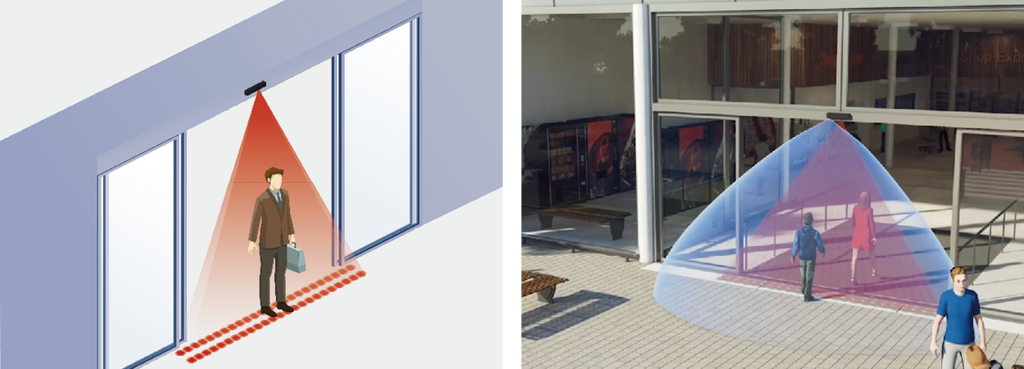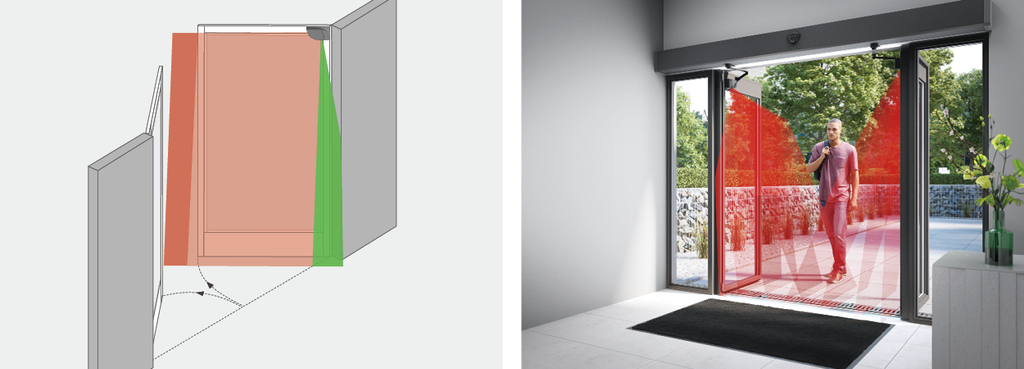Developed over the last several decades, automatic doors are now widely used – from airports, shopping centres, office buildings to hotels and have essentially become an integral part of different industries. Automatic doors not only offer added convenience, improved safety, a seamless, hands-free entry experience to pedestrians but also bring along various benefits such as energy saving and hygiene.
Like any other modern convenience, the ongoing trend with smart community and smart home allows automatic doors to gain traction and popularity in domestic properties. Especially in areas like residential entrances, balconies, and kitchens, the use of automatic doors are becoming an increasingly common sight. Comparatively to that of commercial buildings, subway stations, the use of automatic doors in domestic properties cater to a different group of consumers who require more care and protection such as elderly, children, pregnant women or people with reduced mobility or differently abled. Automatic doors provide unparalleled access where it makes it easy for users, without having to fumble with a difficult door handle or push open a heavy door, or touching a freezing door handle in winter. In addition, it helps to improve the hygiene of premises by reducing the amount of contact between people and door handles, preventing the spread of germs. While the use of automatic doors offer unbeatable convenience and a myraid of benefits, we must not turn a blind eye to the safety aspect that comes along with it as well.
Within the community, there are different groups of consumers with varying levels of mobility – Ranging from young children who are curious by nature and enjoy exploring, to elderly who walk at relatively slower pace, to those carrying heavy pacakages, luggages or even those with children in tow. Regardless of ages or physical capabilities, ensuring that every pedestrian passing through an automatic door safely is one of the key priorities that the owners, developers and even automatic door manufacturers must consider.
Safety of Automatic Sliding Doors
Comfortable, versatile and pleasing to the eye, automatic sliding doors is the ideal choice for door entrances as they let in ample amount of air and natural sunlight. From a safety standpoint, it is key that the moving door leaf does not come into contact with pedestrians or objects in the pathway during opening and closing. In other words, there must be detection and protection on both sides of moving path of the movable door leaf.

Designed specifically for automatic sliding doors, BEA IXIO is the ideal choice of sensor. Using two infrared curtains consisting of 48 high-density infrared spots, BEA IXIO can detect objects or even pedestrians standing underneath, protecting one from any form of contact with the door. Conforming to both GB/T 34616-2017, EN 16005 and DIN 18650, the National and European standards the use of test body on BEA IXIO suggests that it can be effectively detected in all positions of door travel. This is also in line where safety coverage is fulfilled, providing passerbys with an ease of mind. In addition, the product provides 4 red spotlights visible on the floor, assisting installers to quickly and accurately adjust the safety curtain to desired position, ensuring a reliable and safe protection for passerbys.
Safety of Automatic Swing Doors
Automatic swing doors are ubiquitous and don’t appear to be going anywhere anytime soon. In fact, it’s becoming more popular amongst door unit entrances as it is simple to install, easy to upgrade existing manual swing doors to automated swings doors, no special requirements for door body and in fact are well-insulated, good at containing humidity. While this kind of doors open effortlessly, it is essential we do not neglect about the safety aspect as well. One should ensure that when a swing door opens or closes, the door fans should not collide with pedestrians or objects within the pathway. Irrespective of manual or automatic doors, we must also pay special attention to the hinge area where arm or finger entrapment may occur especially within residential communities where there are children and pets.

Designed specifically for the swing door market, the BEA LZR-FLATSCAN SW is a state of the art sensor where it is compact and easy to install. Using the Time-of-Flight (ToF) laser technology, FLATSCAN SW generates 170 measurement points across the door leaf, providing complete protection for swing doors and their users. The sensor distinguishes three functional zones respectively, with door leaf for anti-collision, hinge zone for anti-pinch, as well as leading edge of the door for enhanced safety. Furthermore, with the help of the in-built gyroscope, the sensor can identify the position of door movement and dynamically adjust the size of each zone to adapt to the environment automatically. For example – In narrow walkways where the door leaf is very close to the wall or in environment surrounded by plants or handrails e.t.c, FLATSCAN SW is independent of these objects present in the direct surroundings of the door during teach-in session.

Besides, LZR-FLATSCAN 3D SW provide four curtains with edge-to-edge protection hinge zone and extended field protection, significantly improving the detection accuracy and ensuring the effectiveness of anti-pinch and collision. If a person or an object is present in the pathway, it will pick up this detection and only close when the pathway is clear. Also if people try to catch the door while closing the extended edge can detect and reactivate the door opening preventing injuries. Any risk of contact with the door is prevented, significantly improving passerby’s comfort and is especially friendly to elderly and children. In addition, the multi-layer curtain can be used for door opening detection after the door close. By reducing the use of multiple sensors and eliminating additional wiring and installation, the FLATSCAN 3D SW is the culmination of automatic swing door sensors and most suitable solution for residential environments.
Household Automatic Doors
In recent years, the concept of smart homes has become increasingly popular, automatic curtains, automatic adjustment of temperature, humidity and lighting, remote monitoring, and other intelligent solutions. For some high-end luxurious residential, the balconies and kitchens’ doors are gradually adopting the use of automatic doors, especially sliding doors. For household applications where children often play at the balcony area, and hosts serve hot dishes and soup in and out kitchen, the use of automatic doors in household calls for a higher level of protection, notably for smaller objects such as hands, feet and arms.
BEA LZR-FLATSCAN SL is multi-functional sensor designed for sliding doors. With a laser curtain of 400 interlaced spots, FLATSCAN SL detection capabilities further exceeds from that of a standard sensor as defined by National and European standards. For example – At a mounting height of 4 meters, it can detect object size of 5cm. Since the mounting height and detected object size is directly proportional, this means at a mounting height of 4 meters and below, smaller objects can also be detected, in turn providing reliably protection of both objects and users within a household.

At the same time, FLATSCAN SL can set two virtual buttons for opening, refer to the green areas showing in the image, and the buttons’ size and position are adjustable arbitrarily within the curtain range. For example, you can set a long vertical button at the entrance of the kitchen door to allow both adults and children use it simultaneously. In addition, for balcony door application where we consider pets entering and exiting, you can set another virtual button for pets to open the door in the appropriate position.
For individual home doors, one does not need to leave it closed around the clock. In instances when weather is fine, users have the choice to keep the door open for ventilation. To do so, users can hold the virtual push button for merely 2 to 3 seconds (configurable) and the door will be kept open infinitely. Similarly, simply trigger the button again when required to close the door.
In addition, the FLATSCAN SL is compact in size, which enables discreet recessed mounting in either door cover or ceiling, providing a sleek finished look without affecting the original home style. Thanks to the virtual button function of FLATSCAN SL, it eliminates the need for additional grooving and wiring during renovation, greatly simplifying installation process, thus saving time and effort.
With respect to the protection of automatic doors, apart from the detection ability and coverage of the sensor itself, another important point of attention is the product’s reliability. Safety-related equipment must meet the performance class PL’C’ or PL’D’ that required in EN ISO 13849-1 or GB/T 16855.1-2018, according to the European standard EN16005 “Electric pedestrian door use safety requirements and test methods” and group standard T/ CCMSA 10925-2021 “Sensors for Building Doors”. Therefore, ensuring the sensor and door controller are reliable enough is essential to enhance the safety of the detection system and protection solution.
Residential environment is one where people live in, interact and spend a lot of their time at. While the use of automatic doors offer convenience in our daily lives, we must not neglect that the safety aspect of it either. By selecting products that conform to standard requirements for an automatic door, will undoubtedly help both owners and vistors create a peace of mind.

